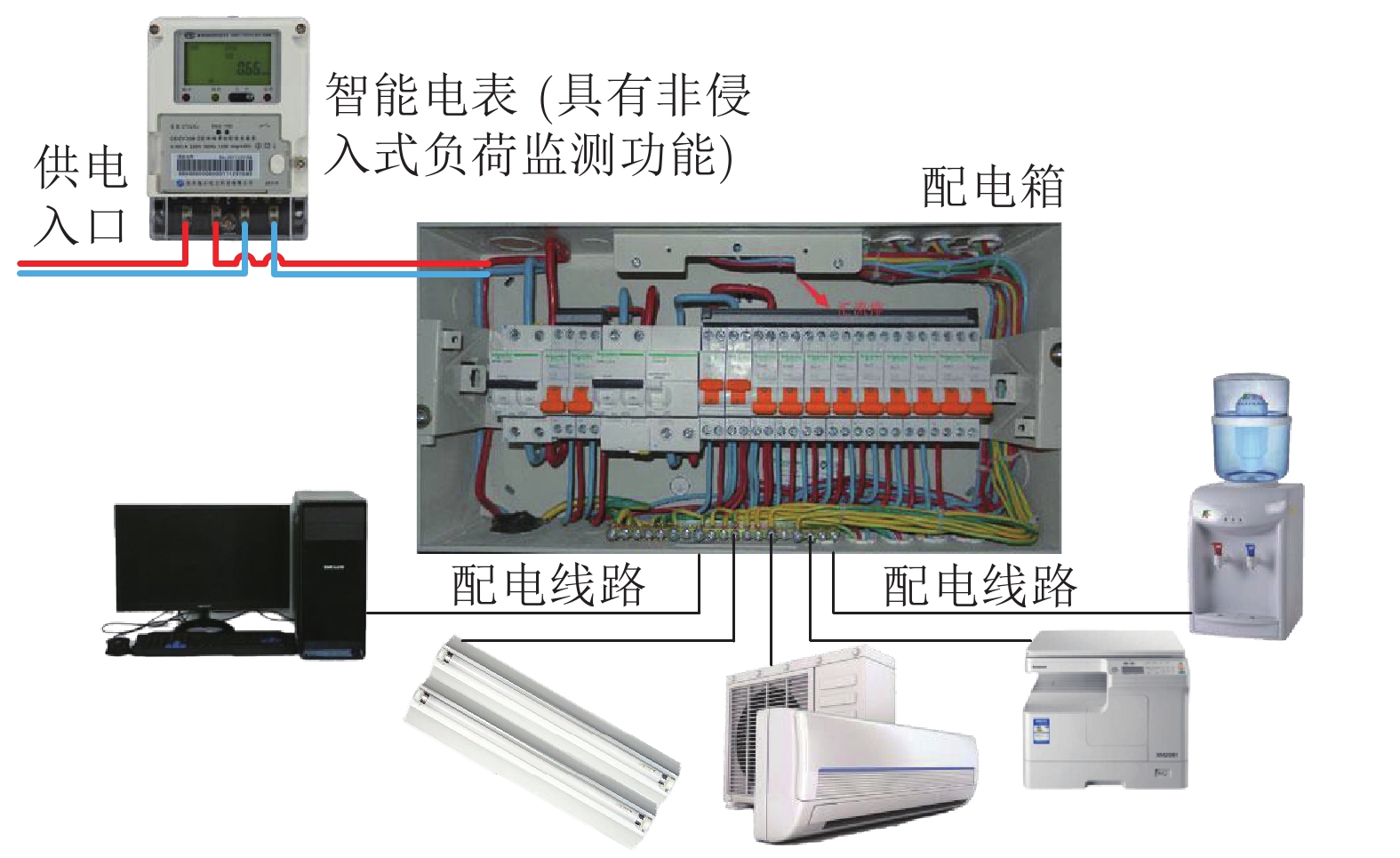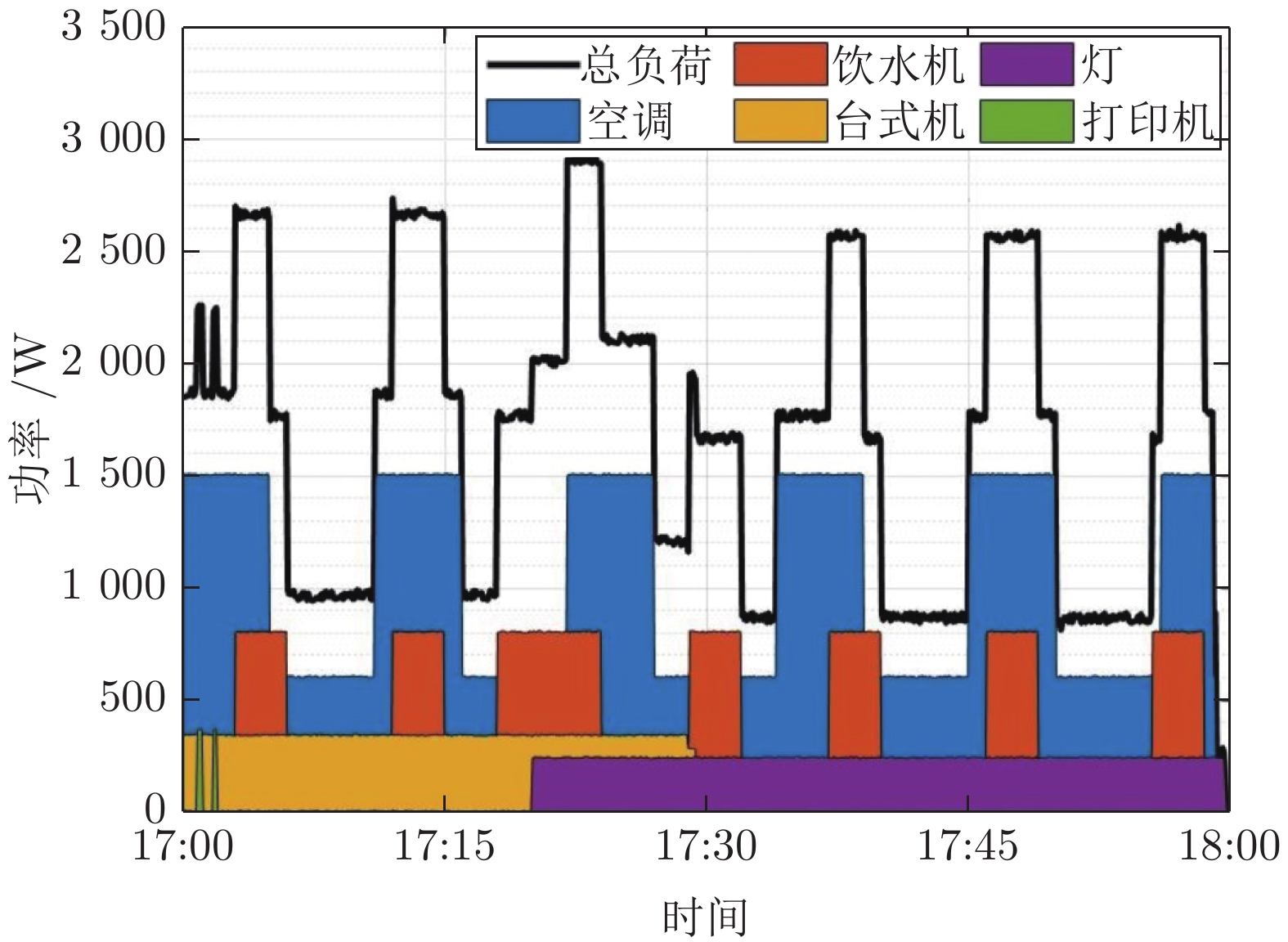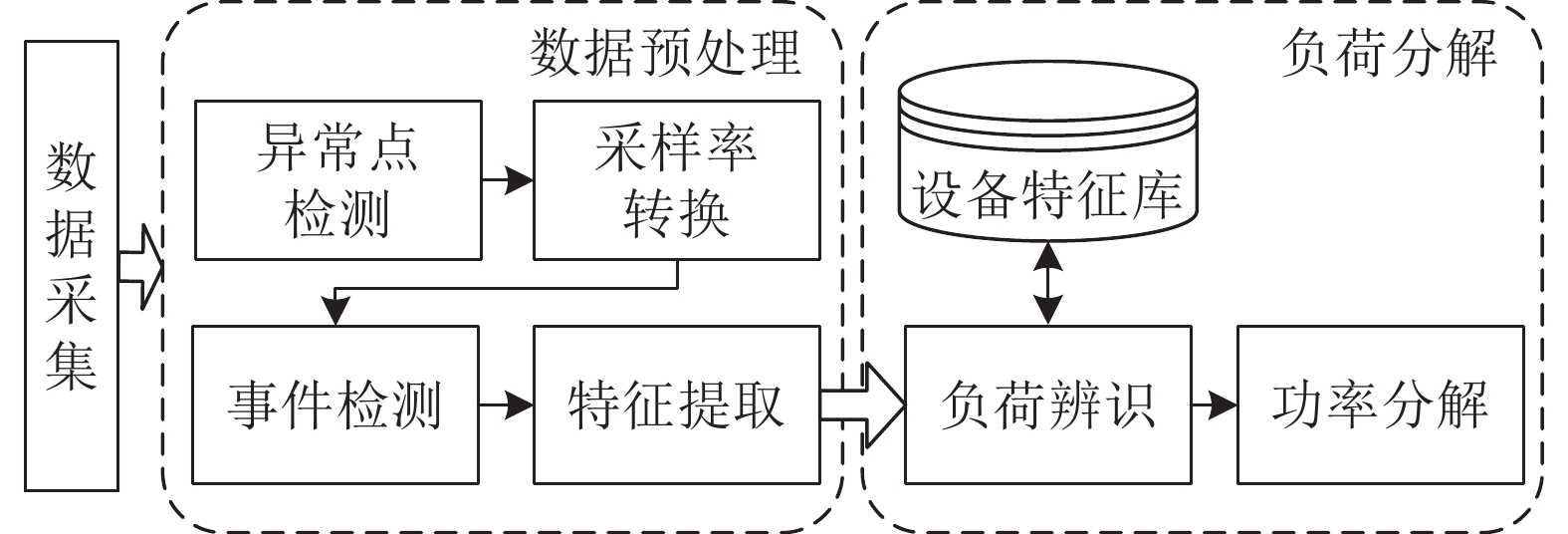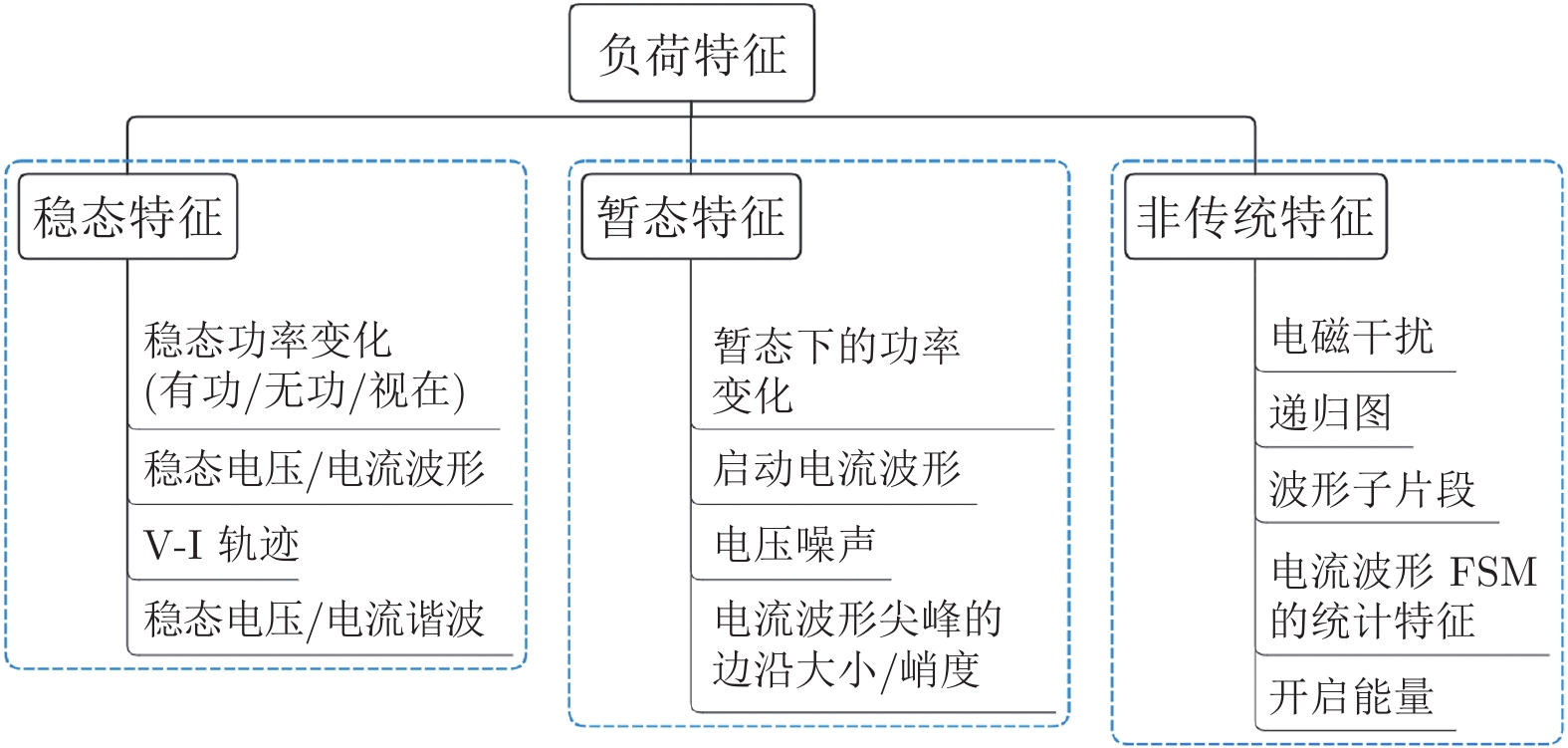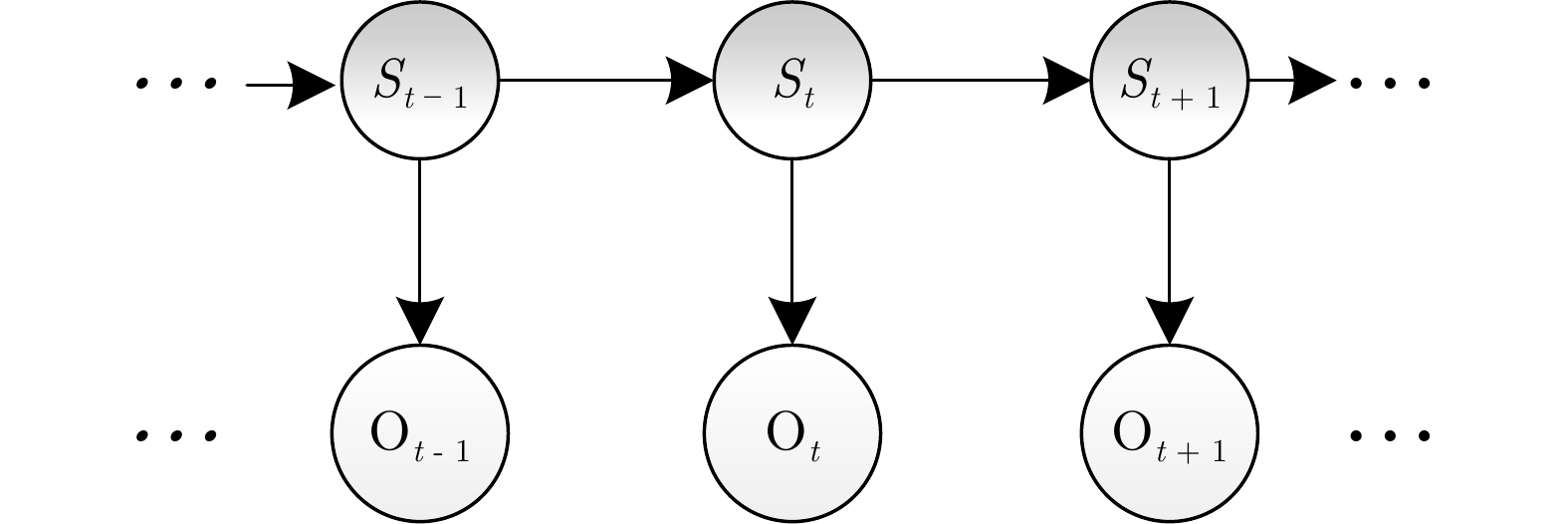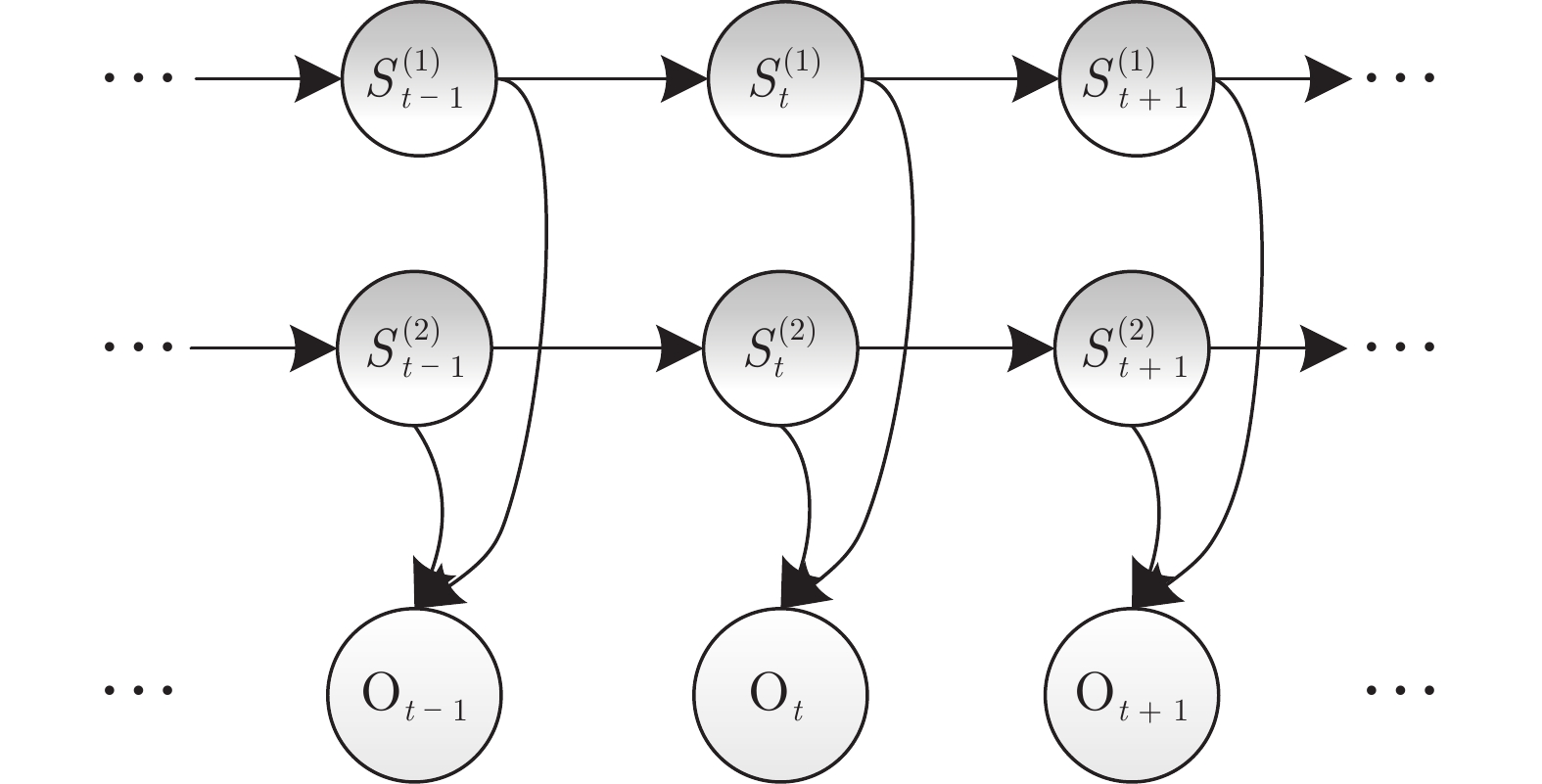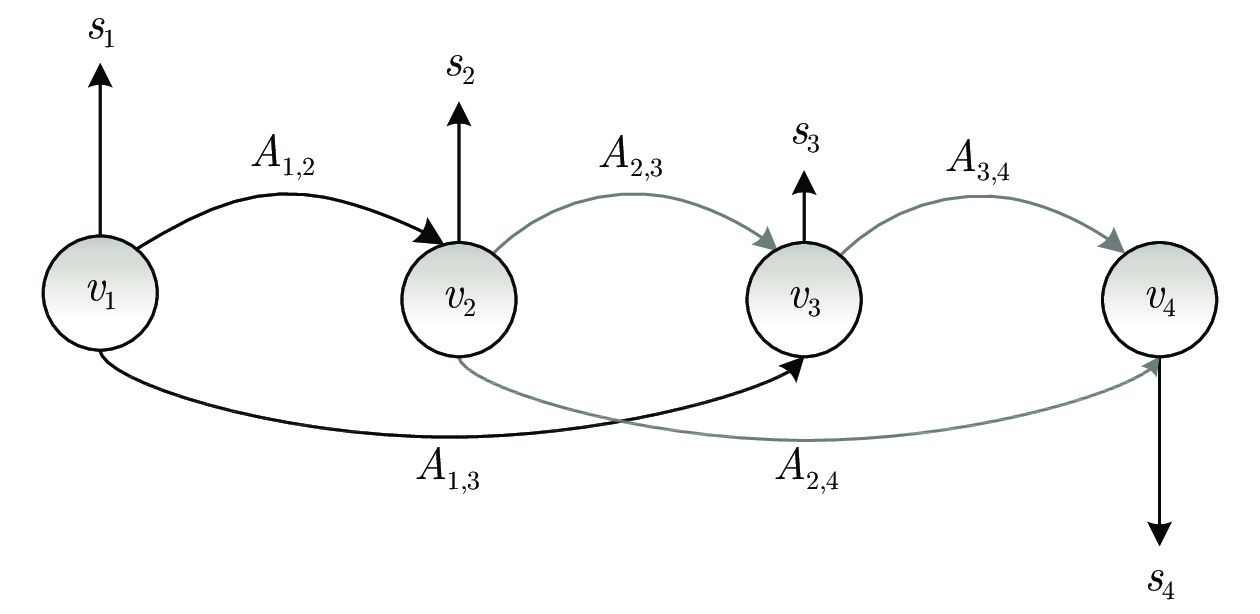-
摘要: 非侵入式负荷监测通过对总负荷电表数据进行分析处理, 能够实现对各个用电设备及其工作状态的辨识, 可广泛应用于建筑节能、智慧城市、智能电网等领域. 近年来, 随着智能电表的大规模部署以及各类机器学习算法的广泛应用, 非侵入式负荷监测引起了学术界与工业界的共同关注. 本文对非侵入式负荷监测方面的研究进行综述. 首先提炼非侵入式负荷监测的问题模型及基本框架; 然后分别对非侵入式负荷监测的数据采集与预处理过程、负荷分解模型与方法、常用数据集及评估指标进行归纳总结; 最后, 对目前研究中存在的挑战进行分析, 并对未来的研究方向进行展望.Abstract: Non-intrusive load monitoring can realize the identification of individual electrical equipment and its working state by analyzing and processing the aggregated load data from electricity meters, which can be widely used in building energy conservation, smart cities, smart grids, etc. With the large-scale deployment of smart meters and the widespread application of various machine learning algorithms, non-intrusive load monitoring has aroused the common concern of academia and industry in recent years. This article reviews the research on non-intrusive load monitoring. First, the mathematical model and basic framework of non-intrusive load monitoring are refined, and then we separately summarize the data collection and pre-processing process, load disaggregation models and algorithms, data sets and evaluation metrics used in non-intrusive load monitoring. Finally, some challenges that the current research are confronted with are analyzed and we give some views on the future research.
-
表 1 NILM方法优缺点对比
Table 1 Comparison of NILM methods
方法 优点 缺点 HMM 模型直观 运算量大 精确推理困难 GSP 表征能力强 现有算法相对较少 训练周期短 运算复杂度较低 ML 自动提取特征 模型参数多 分解准确率高 训练所需数据量大 泛化性能好 可解释性差 表 2 非侵入式负荷监测公开数据集
Table 2 Publicly available datasets for NILM
数据集 地点 采集持续时间 房屋
数量传感器数量/
房屋采集频率 采集参数1 其他数据 REDD[9] 美国 几天 ~ 数月 6 10 ~ 24 15 kHz (Agg);
0.5 Hz, 1 Hz (Sub)V, P (Agg); P (Sub) BERDS[149] 美国 1 年 1 NA 20 s P, Q, S 气候数据 BLUED[150] 美国 8 天 1 1 12 kHz (Agg);
20 Hz (Sub)I, V (P通过计算
得出@60 Hz)各设备的状态转换标签 Smart* Home[151] 美国 3 个月 3 A : 26;
B, C : 211 Hz P, S (Agg); P (Sub) 太阳能和风力发电数据, 气候,
室内温湿度数据DRED[152] 荷兰 6 个月 3 12 1 Hz E, P (Agg & Sub) 室内外温度, 风速, 降水, 入住率,
房屋布局, 设备配置, 无线信号Tracebase[153] 德国 1883 天
(累计)15 NA 1 s, 8 s (Sub) P (Sub) 用于设备识别, 未采集总表数据 AMPds2[21, 154] 加拿大 2 年 1 21 1 min V, I, F, P, Q, S,
F, E 等 10 项水表、天然气表数据,
电费账单数据UK-DALE[155] 英国 2 个月 ~ 4.3 年 5 5 ~ 54 16 kHz (I, V of Agg); 6 s (Agg & Sub);
1 s (Agg)P, I, V 设备状态切换信息,
住户人员构成
及能源构成信息iAWE[156] 印度 73 天 1 33 1 Hz (Agg);
1 s, 6 s (Sub)V, I, F, P, ph 用水量和环境数据 (温度, 人员
活动, 声音及无线信号强度)REFIT[157] 英国 2 年 20 10 8 s P 天然气表和环境数据 GREEND[159] 意大利/
奥地利1 年 9 9 1 Hz P 用电负荷配置, 住户情况描述 ECO[34] 瑞士 8 个月 6 6 ~ 10 1 Hz P, Q 住户情况描述 PLAID[160] 美国 — 56 共 11 类, 大于 200 个设备 30 kHz I, V EMBED[161] 美国 14 ~ 27 天 3 共 21 类, 约
40 个设备12 kHz (Agg);
1 ~ 2 Hz (Sub)I, V, P, Q, F 各设备的状态转换标签, 入住率 1 Agg: 总表; Sub: 分表; P: 有功功率; Q: 无功功率; S: 视在功率; E: 电量; F: 频率; V: 电压; I: 电流; ph: 相位. -
[1] Hart G W. Nonintrusive appliance load monitoring. Proceedings of the IEEE, 1992, 80(12): 1870-1891 doi: 10.1109/5.192069 [2] Batra N, Singh A, Whitehouse K. If you measure it, can you improve it? Exploring the value of energy disaggregation. In: Proceedings of the 2nd ACM International Conference on Embedded Systems for Energy-Efficient Built Environments. Seoul, South Korea: ACM, 2015. 191−200 [3] Bergés M, Goldman E, Matthews H S, Soibelman L. Enhancing electricity audits in residential buildings with nonintrusive load monitoring. Journal of Industrial Ecology, 2010, 14(5): 844-858 doi: 10.1111/j.1530-9290.2010.00280.x [4] Papadopoulos P M, Reppa V, Polycarpou M M, Panayiotou C G. Scalable distributed sensor fault diagnosis for smart buildings. IEEE/CAA Journal of Automatica Sinica, 2020, 7(3): 638-655 doi: 10.1109/JAS.2020.1003123 [5] Qin J H, Wan Y N, Yu X H, Li F Y, Li C J. Consensus-based distributed coordination between economic dispatch and demand response. IEEE Transactions on Smart Grid, 2019, 10(4): 3709-3719 doi: 10.1109/TSG.2018.2834368 [6] Wang Y, Chen Q X, Hong T, Kang C Q. Review of smart meter data analytics: Applications, methodologies, and challenges. IEEE Transactions on Smart Grid, 2019, 10(3): 3125-3148 doi: 10.1109/TSG.2018.2818167 [7] Mohassel R R, Fung A, Mohammadi F, Raahemifar K. A survey on advanced metering infrastructure. International Journal of Electrical Power and Energy Systems, 2014, 63: 473-484 [8] Armel K C, Gupta A, Shrimali G, Albert A. Is disaggregation the holy grail of energy efficiency? The case of electricity. Energy Policy, 2013, 52: 213-234 doi: 10.1016/j.enpol.2012.08.062 [9] Kolter J Z, Johnson M J. Redd: a public data set for energy disaggregation research. In: Proceedings of the 1st SustKDD Workshop on Data Mining Applications in Sustainability. San Diego, USA: ACM, 2011. 1−6 [10] Batra N, Parson O, Bergés M, Singh A, Rogers A. A comparison of non-intrusive load monitoring methods for commercial and residential buildings. arXiv: 1408.6595, 2014. [11] Zeifman M, Roth K. Nonintrusive appliance load monitoring: Review and outlook. IEEE Transactions on Consumer Electronics, 2011, 57(1): 76-84 doi: 10.1109/TCE.2011.5735484 [12] Kelly J, Knottenbelt W. Neural NILM: Deep neural networks applied to energy disaggregation. In: Proceedings of the 2nd ACM International Conference on Embedded Systems for Energy-Efficient Built Environments. Seoul, South Korea: ACM, 2015. 55−64 [13] Zhang C Y, Zhong M J, Wang Z Z, Goddard N, Sutton C. Sequence-to-point learning with neural networks for non-intrusive load monitoring. In: Proceedings of the 2017 AAAI Conference on Artificial Intelligence. New Orleans, USA: AAAI, 2017. [14] Calamaro N, Donko M, Shmilovitz D. A highly accurate nilm: with an electro-spectral space that best fits algorithm's national deployment requirements. Energies, 2021, 14(21): 7410 [15] Zeifman M, Roth K. Viterbi algorithm with sparse transitions (vast) for nonintrusive load monitoring. In: Proceedings of the 2011 IEEE Symposium on Computational Intelligence Applications in Smart Grid (CIASG). Paris, France: IEEE, 2011. 1−8 [16] Nakajima H, Nagasawa K, Shishido Y, Kagiya Y, Takagi Y. The state estimation of existing home appliances using signal analysis technique. In: Proceedings of the 2014 SICE Annual Conference (SICE). Sapporo, Japan: IEEE, 2014. 1247−1252 [17] Makonin S, Popowich F, Bajić I V, Gill B, Bartram L. Exploiting hmm sparsity to perform online real-time nonintrusive load monitoring. IEEE Transactions on Smart Grid, 2016, 7(6): 2575-2585 doi: 10.1109/TSG.2015.2494592 [18] Nguyen T K, Dekneuvel E, Jacquemod G, Nicolle B, Zammit O, Nguyen V C. Development of a real-time non-intrusive appliance load monitoring system: An application level model. International Journal of Electrical Power and Energy Systems, 2017, 90: 168-180 [19] Gisler C, Ridi A, Zufferey D, Khaled O A, Hennebert J. Appliance consumption signature database and recognition test protocols. In: Proceedings of the 8th International Workshop on Systems, Signal Processing and their Applications (WoSSPA). Algiers, Algeria: IEEE, 2013. 336−341 [20] Mei J, He D W, Harley R G, Habetler T G. Random forest based adaptive non-intrusive load identification. In: Proceedings of the 2014 International Joint Conference on Neural Networks (IJCNN). Beijing, China: IEEE, 2014. 1978−1983 [21] Makonin S, Ellert B, Bajić I V, Popowich F. Electricity, water, and natural gas consumption of a residential house in Canada from 2012 to 2014. Scientific Data, 2016, 3: Article No. 160037 doi: 10.1038/sdata.2016.37 [22] Hart G W. Prototype Nonintrusive Appliance Load Monitor, Technical Report RP. 2568-2, MIT Energy Laboratory and EPRI, USA, 1985, [23] Simpson C D. Principles of Electronics. Upper Saddle River: Prentice Hall, 1996. 85−102 [24] Lee K D, Leeb S B, Norford L K, Armstrong P R, Holloway J, Shaw S R. Estimation of variable-speed-drive power consumption from harmonic content. IEEE Transactions on Energy Conversion, 2005, 20(3): 566-574 doi: 10.1109/TEC.2005.852963 [25] Wichakool W, Avestruz A T, Cox R W, Leeb S B. Modeling and estimating current harmonics of variable electronic loads. IEEE Transactions on Power Electronics, 2009, 24(12): 2803-2811 doi: 10.1109/TPEL.2009.2029231 [26] Gupta S, Reynolds M S, Patel S N. ElectriSense: Single-point sensing using EMI for electrical event detection and classification in the home. In: Proceedings of the 12th ACM International Conference on Ubiquitous Computing. Copenhagen, Denmark: ACM, 2010. 139−148 [27] Tsai M S, Lin Y H. Modern development of an adaptive non-intrusive appliance load monitoring system in electricity energy conservation. Applied Energy, 2012, 96: 55-73 doi: 10.1016/j.apenergy.2011.11.027 [28] Ahmadi H, Martí J R. Load decomposition at smart meters level using eigenloads approach. IEEE Transactions on Power Systems, 2015, 30(6): 3425-3436 doi: 10.1109/TPWRS.2014.2388193 [29] Leeb S B, Shaw S R, Kirtley J L. Transient event detection in spectral envelope estimates for nonintrusive load monitoring. IEEE Transactions on Power Delivery, 1995, 10(3): 1200-1210 doi: 10.1109/61.400897 [30] Baranski M, Voss J. Nonintrusive appliance load monitoring based on an optical sensor. In: Proceedings of the 2003 IEEE Bologna Power Tech Conference. Bologna, Italy: IEEE, 2003. Article No. 8 [31] Klemenjak C, Egarter D, Elmenreich W. YoMo: The Arduino-based smart metering board. Computer Science-Research and Development, 2016, 31(1-2): 97-103 doi: 10.1007/s00450-014-0290-8 [32] Makonin S, Sung W, Cruz R D, Yarrow B, Gill B, Popowich F, et al. Inspiring energy conservation through open source metering hardware and embedded real-time load disaggregation. In: Proceedings of the 2013 IEEE PES Asia-Pacific Power and Energy Engineering Conference (APPEEC). Hong Kong, China: IEEE, 2013. 1−6 [33] Batra N, Dutta H, Singh A. INDiC: Improved non-intrusive load monitoring using load division and calibration. In: Proceedings of the 12th International Conference on Machine Learning and Applications. Miami, USA: IEEE, 2013. 79−84 [34] Beckel C, Kleiminger W, Cicchetti R, Staake T, Santini S. The eco data set and the performance of non-intrusive load monitoring algorithms. In: Proceedings of the 1st ACM Conference on Embedded Systems for Energy-Efficient Buildings. Memphis, USA: ACM, 2014. 80−89 [35] Powers J T, Margossian B, Smith B A. Using a rule-based algorithm to disaggregate end-use load profiles from premise-level data. IEEE Computer Applications in Power, 1991, 4(2): 42-47 doi: 10.1109/67.75875 [36] Bergés M, Goldman E, Matthews H S, Soibelman L. Training load monitoring algorithms on highly sub-metered home electricity consumption data. Tsinghua Science and Technology, 2008, 13(S1): 406-411 [37] Anderson K D, Bergés M, Ocneanu A, Benitez D, Moura J M F. Event detection for non intrusive load monitoring. In: Proceedings of the 38th Annual Conference on IEEE Industrial Electronics Society. Montreal, Canada: IEEE, 2012. 3312−3317 [38] Rudin L I, Osher S, Fatemi E. Nonlinear total variation based noise removal algorithms. Physica D: Nonlinear Phenomena, 1992, 60(1-4): 259-268 doi: 10.1016/0167-2789(92)90242-F [39] Laughman C, Lee K, Cox R, Shaw S, Leeb S, Norford L, et al. Power Signature Analysis. IEEE Power and Energy Magazine, 2003, 1(2): 56-63 doi: 10.1109/MPAE.2003.1192027 [40] Shaw S R, Leeb S B, Norford L K, Cox R W. Nonintrusive load monitoring and diagnostics in power systems. IEEE Transactions on Instrumentation and Measurement, 2008, 57(7): 1445-1454 doi: 10.1109/TIM.2008.917179 [41] Peach N, Basseville M, Nikiforov I V. Detection of abrupt changes: Theory and applications. Journal of the Royal Statistical Society Series A-Statistics in Society, 1995, 158(1): 185-186 doi: 10.2307/2983416 [42] Luo D, Norford L, Shaw S R, Leeb S B. Monitoring HVAC equipment electrical loads from a centralized location-methods and field test results. ASHRAE Transactions, 2002, 108(1): 841-857 [43] Jazizadeh F. Building energy monitoring realization: Context-aware event detection algorithms for non-intrusive electricity disaggregation. In: Proceedings of the 2016 American Society of Civil Engineers Construction Research Congress. San Juan, Puerto Rico, USA: ASCE, 2016. 839−848 [44] Jin Y W, Tebekaemi E, Bergés M, Soibelman L. Robust adaptive event detection in non-intrusive load monitoring for energy aware smart facilities. In: Proceedings of the 2011 IEEE International Conference on Acoustics, Speech and Signal Processing. Prague, Czech Republic: IEEE, 2011. 4340−4343 [45] Yang C C, Soh C S, Yap V V. Comparative study of event detection methods for non-intrusive appliance load monitoring. Energy Procedia, 2014, 61: 1840-1843 doi: 10.1016/j.egypro.2014.12.225 [46] De Baets L, Ruyssinck J, Develder C, Dhaene T, Deschrijver D. On the Bayesian optimization and robustness of event detection methods in NILM. Energy and Buildings, 2017, 145: 57-66 doi: 10.1016/j.enbuild.2017.03.061 [47] Zhu Z C, Wei Z Q, Yin B, Zhang S, Wang X. A novel approach for event detection in non-intrusive load monitoring. In: Proceedings of the 2017 IEEE Conference on Energy Internet and Energy System Integration (EI2). Beijing, China: IEEE, 2017. 1−5 [48] Afzalan M, Jazizadeh F, Wang J. Self-configuring event detection in electricity monitoring for human-building interaction. Energy and Buildings, 2019, 187: 95-109 doi: 10.1016/j.enbuild.2019.01.036 [49] Bhattacharjee S, Kumar A, RoyChowdhury J. Appliance classification using energy disaggregation in smart homes. In: Proceedings of the 2014 International Conference on Computation of Power, Energy, Information and Communication (ICCPEIC). Chennai, India: IEEE, 2014. 1−6 [50] Chou P A, Chang R I. Unsupervised adaptive non-intrusive load monitoring system. In: Proceedings of the 2013 IEEE International Conference on Systems, Man, and Cybernetics. Manchester, UK: IEEE, 2013. 3180−3185 [51] Egarter D, Bhuvana V P, Elmenreich W. PALDi: Online load disaggregation via particle filtering. IEEE Transactions on Instrumentation and Measurement, 2015, 64(2): 467-477 doi: 10.1109/TIM.2014.2344373 [52] Figueiredo M, Ribeiro B, De Almeida A. Electrical signal source separation via nonnegative tensor factorization using on site measurements in a smart home. IEEE Transactions on Instrumentation and Measurement, 2014, 63(2): 364-373 doi: 10.1109/TIM.2013.2278596 [53] Gabaldón A, Ortiz-García M, Molina R, Valero-Verdú S. Disaggregation of the electric loads of small customers through the application of the Hilbert transform. Energy Efficiency, 2014, 7(4): 711-728 doi: 10.1007/s12053-013-9250-6 [54] Kramer O, Klingenberg T, Sonnenschein M, Wilken O. Non-intrusive appliance load monitoring with bagging classifiers. Logic Journal of the IGPL, 2015, 23(3): 359-368 doi: 10.1093/jigpal/jzv016 [55] Wang X J, Lei D M, Yong J, Zeng L Q, West S. An online load identification algorithm for non-intrusive load monitoring in homes. In: Proceedings of the 8th International Conference on Intelligent Sensors, Sensor Networks and Information. Melbourne, Australia: IEEE, 2013. 1−6 [56] Wang Z Y, Zheng G L. Residential appliances identification and monitoring by a nonintrusive method. IEEE Transactions on Smart Grid, 2012, 3(1): 80-92 doi: 10.1109/TSG.2011.2163950 [57] Racines D, Candelo J E, Montaña J. Non-intrusive electrical load monitoring system applying neural networks with combined steady-state electrical Variables. Tehnicki Vjesnik, 2018, 25(5): 1321-1329 [58] Lu L L, Park S W, Wang B H. Electric load signature analysis for home energy monitoring system. International Journal of Fuzzy Logic and Intelligent Systems, 2012, 12(3): 193-197 doi: 10.5391/IJFIS.2012.12.3.193 [59] Basu K, Debusschere V, Bacha S. Load identification from power recordings at meter panel in residential households. In: Proceedings of the 2012 International Conference on Electrical Machines. Marseille, France: IEEE, 2012. 2098−2104 [60] Tina G M, Amenta V A, Tomarchio O, Di Modica G. Web interactive non intrusive load disaggregation system for active demand in smart grids. EAI Endorsed Transactions on Energy, 2014, 1(3): 1-9 doi: 10.4108/ew.1.3.e1 [61] Hassan T, Javed F, Arshad N. An empirical investigation of V-I trajectory based load signatures for non-intrusive load monitoring. IEEE Transactions on Smart Grid, 2014, 5(2): 870-878 doi: 10.1109/TSG.2013.2271282 [62] Du L, He D W, Harley R G, Habetler T G. Electric load classification by binary voltage-current trajectory mapping. IEEE Transactions on Smart Grid, 2016, 7(1): 358-365 doi: 10.1109/TSG.2015.2442225 [63] Wang A L, Chen B X, Wang C G, Hua D D. Non-intrusive load monitoring algorithm based on features of V–I trajectory. Electric Power Systems Research, 2018, 157: 134-144 doi: 10.1016/j.jpgr.2017.12.012 [64] Baptista D, Mostafa S S, Pereira L, Sousa L, Morgado-Dias F. Implementation strategy of convolution neural networks on field programmable gate arrays for appliance classification using the voltage and current (V-I) trajectory. Energies, 2018, 11(9): Article No. 2460 doi: 10.3390/en11092460 [65] Yang C C, Soh C S, Yap V V. A systematic approach in load disaggregation utilizing a multi-stage classification algorithm for consumer electrical appliances classification. Frontiers in Energy, 2019, 13(2): 386-398 doi: 10.1007/s11708-017-0497-z [66] Liu Y C, Wang X, You W. Non-intrusive load monitoring by voltage-current trajectory enabled transfer learning. IEEE Transactions on Smart Grid, 2019, 10(5): 5609-5619 doi: 10.1109/TSG.2018.2888581 [67] Wild B, Barsim K S, Yang B. A new unsupervised event detector for non-intrusive load monitoring. In: Proceedings of the 2015 Global Conference on Signal and Information Processing (GlobalSIP). Orlando, USA: IEEE, 2015. 73−77 [68] He D W, Lin W X, Liu N, Harley R G, Habetler T G. Incorporating non-intrusive load monitoring into building level demand response. IEEE Transactions on Smart Grid, 2013, 4(4): 1870-1877 doi: 10.1109/TSG.2013.2258180 [69] Du L, Restrepo J A, Yang Y, Harley R G, Habetler T G. Nonintrusive, self-organizing, and probabilistic classification and identification of plugged-in electric loads. IEEE Transactions on Smart Grid, 2013, 4(3): 1371-1380 doi: 10.1109/TSG.2013.2263231 [70] Chang H H, Lin L S, Chen N M, Lee W J. Particle-swarm-optimization-based nonintrusive demand monitoring and load identification in smart meters. IEEE Transactions on Industry Applications, 2013, 49(5): 2229-2236 doi: 10.1109/TIA.2013.2258875 [71] Bouhouras A S, Gkaidatzis P A, Chatzisavvas K C, Panagiotou E, Poulakis N, Christoforidis G C. Load signature formulation for non-intrusive load monitoring based on current measurements. Energies, 2017, 10(4): Article No. 538 doi: 10.3390/en10040538 [72] Jimenez Y, Duarte C, Petit J, Meyer J, Schegner P, Carrrillo G. Steady state signatures in the time domain for nonintrusive appliance identification. Ingeniería e Investigación, 2015, 35(Sl): 58-64 [73] Chang H H, Lian K L, Su Y C, Lee W J. Power-spectrum-based wavelet transform for nonintrusive demand monitoring and load identification. IEEE Transactions on Industry Applications, 2014, 50(3): 2081-2089 doi: 10.1109/TIA.2013.2283318 [74] Chen K L, Chang H H, Chen N M. A new transient feature extraction method of power signatures for Nonintrusive Load Monitoring Systems. In: Proceedings of the 2013 IEEE International Workshop on Applied Measurements for Power Systems (AMPS). Aachen, Germany: IEEE, 2013. 79−84 [75] Gillis J M, Morsi W G. Non-intrusive load monitoring using semi-supervised machine learning and wavelet design. IEEE Transactions on Smart Grid, 2017, 8(6): 2648-2655 doi: 10.1109/TSG.2016.2532885 [76] Su Y C, Lian K L, Chang H H. Feature selection of non-intrusive load monitoring system using STFT and wavelet transform. In: Proceedings of the 8th International Conference on e-Business Engineering. Beijing, China: IEEE, 2011. 293−298 [77] Jazizadeh F, Becerik-Gerber B, Bergés M, Soibelman L. An unsupervised hierarchical clustering based heuristic algorithm for facilitated training of electricity consumption disaggregation systems. Advanced Engineering Informatics, 2014, 28(4): 311-326 doi: 10.1016/j.aei.2014.09.004 [78] Jiang L, Luo S H, Li J M. Intelligent electrical appliance event recognition using multi-load decomposition. Advanced Materials Research, 2013, 805-806: 1039-1045 doi: 10.4028/www.scientific.net/AMR.805-806.1039 [79] Borin V P, Barriquello C H, Campos A. Approach for home appliance recognition using vector projection length and Stockwell transform. Electronics Letters, 2015, 51(24): 2035-2037 doi: 10.1049/el.2015.2385 [80] Jimenez Y, Duarte C, Petit J, Carrillo G. Feature extraction for nonintrusive load monitoring based on S-transform. In: Proceedings of the 2014 Clemson University Power Systems Conference. Clemson, USA: IEEE, 2014. 1−5 [81] Cole A I, Albicki A. Data extraction for effective non-intrusive identification of residential power loads. In: Proceedings of the 1998 IEEE Instrumentation and Measurement Technology Conference. St. Paul, USA: IEEE, 1998. 812−815 [82] Patel S N, Robertson T, Kientz J A, Reynolds M S, Abowd G D. At the flick of a switch: Detecting and classifying unique electrical events on the residential power line. In: Proceedings of the 9th International Conference on Ubiquitous Computing. Innsbruck, Austria: Springer, 2007. 271−288 [83] Lin Y H, Tsai M S. Development of an improved time–frequency analysis-based nonintrusive load monitor for load demand identification. IEEE Transactions on Instrumentation and Measurement, 2014, 63(6): 1470-1483 doi: 10.1109/TIM.2013.2289700 [84] Norford L K, Leeb S B. Non-intrusive electrical load monitoring in commercial buildings based on steady-state and transient load-detection algorithms. Energy and Buildings, 1996, 24(1): 51-64 doi: 10.1016/0378-7788(95)00958-2 [85] Chang H H. Non-intrusive demand monitoring and load identification for energy management systems based on transient feature analyses. Energies, 2012, 5(11): 4569-4589 doi: 10.3390/en5114569 [86] Meehan P, McArdle C, Daniels S. An efficient, scalable time-frequency method for tracking energy usage of domestic appliances using a two-step classification algorithm. Energies, 2014, 7: 7041-7066 doi: 10.3390/en7117041 [87] Liang J, Ng S K K, Kendall G, Cheng J W M. Load signature study―part I: Basic concept, structure, and methodology. IEEE Transactions on Power Delivery, 2010, 25(2): 551-560 doi: 10.1109/TPWRD.2009.2033799 [88] Liang J, Ng S K K, Kendall G, Cheng J W M. Load signature study―part II: Disaggregation framework, simulation, and applications. IEEE Transactions on Power Delivery, 2010, 25(2): 561-569 doi: 10.1109/TPWRD.2009.2033800 [89] Gulati M, Ram S S, Singh A. An in depth study into using EMI signatures for appliance identification. In: Proceedings of the 1st ACM Conference on Embedded Systems for Energy-Efficient Buildings. Memphis, USA: ACM, 2014. 70−79 [90] Popescu F, Enache F, Vizitiu I C, Ciotirnae P. Recurrence plot analysis for characterization of appliance load signature. In: Proceedings of the 10th International Conference on Communications (COMM). Bucharest, Romania: IEEE, 2014. 1−4 [91] Patri O P, Panangadan A V, Chelmis C, Prasanna V K. Extracting discriminative features for event-based electricity disaggregation. In: Proceedings of the 2014 IEEE Conference on Technologies for Sustainability. Portland, USA: IEEE, 2014. 232−238 [92] Du L, Yang Y, He D W, Harley R G, Habetler T G. Feature extraction for load identification using long-term operating waveforms. IEEE Transactions on Smart Grid, 2015, 6(2): 819-826 doi: 10.1109/TSG.2014.2373314 [93] Chang H H, Chen K L, Tsai Y P, Lee W J. A new measurement method for power signatures of nonintrusive demand monitoring and load identification. IEEE Transactions on Industry Applications, 2012, 48(2): 764-771 doi: 10.1109/TIA.2011.2180497 [94] Chang H H. Genetic algorithms and non-intrusive energy management system based economic dispatch for cogeneration units. Energy, 2011, 36(1): 181-190 doi: 10.1016/j.energy.2010.10.054 [95] Du Y, Du L, Lu B, Harley R, Habetler T. A review of identification and monitoring methods for electric loads in commercial and residential buildings. In: Proceedings of the 2010 IEEE Energy Conversion Congress and Exposition. Atlanta, USA: IEEE, 2010. 4527−4533 [96] 武昕, 祁兵, 韩璐, 王震, 董超. 基于模板滤波的居民负荷非侵入式快速辨识算法. 电力系统自动化, 2017, 41(2): 135-141 doi: 10.7500/AEPS20160411001Wu Xin, Qi Bing, Han Lu, Wang Zhen, Dong Chao. Fast non-intrusive load identification algorithm for resident load based on template filtering. Automation of Electric Power Systems, 2017, 41(2): 135-141 doi: 10.7500/AEPS20160411001 [97] 程祥, 李林芝, 吴浩, 丁一, 宋永华, 孙维真. 非侵入式负荷监测与分解研究综述. 电网技术, 2016, 40(10): 3108-3117Cheng Xiang, Li Lin-Zhi, Wu Hao, Ding Yi, Song Yong-Hua, Sun Wei-Zhen. A survey of the research on non-intrusive load monitoring and disaggregation. Power System Technology, 2016, 40(10): 3108-3117 [98] Dong M, Meira P C M, Xu W, Freitas W. An event window based load monitoring technique for smart meters. IEEE Transactions on Smart Grid, 2012, 3(2): 787-796 doi: 10.1109/TSG.2012.2185522 [99] Kolter J Z, Jaakkola T. Approximate inference in additive factorial HMMs with application to energy disaggregation. In: Proceedings of the 5th International Conference on Artificial Intelligence and Statistics. Canary Islands, Spain: JMLR, 2012. 1472−1482 [100] Figueiredo M, De Almeida A, Ribeiro B. Home electrical signal disaggregation for non-intrusive load monitoring (NILM) systems. Neurocomputing, 2012, 96: 66-73 doi: 10.1016/j.neucom.2011.10.037 [101] Yang C C, Soh C S, Yap V V. A systematic approach in appliance disaggregation using k-nearest neighbours and naive Bayes classifiers for energy efficiency. Energy Efficiency, 2018, 11(1): 239-259 doi: 10.1007/s12053-017-9561-0 [102] Hidiyanto F, Halim A. Knn methods with varied k, distance and training data to disaggregate nilm with similar load characteristic. In: Proceedings of the 3rd Asia Pacific Conference on Research in Industrial and Systems Engineering (APCORISE 2020). Depok, Indonesia: ACM, 2020. 93−99 [103] Nguyen M, Alshareef S, Gilani A, Morsi W G. A novel feature extraction and classification algorithm based on power components using single-point monitoring for NILM. In: Proceedings of the 28th Canadian Conference on Electrical and Computer Engineering (CCECE). Halifax, Canada: IEEE, 2015. 37−40 [104] Buddhahai B, Wongseree W, Rakkwamsuk P. A non-intrusive load monitoring system using multi-label classification approach. Sustainable Cities and Society, 2018, 39(10): 621-630 [105] Hoyo-Montano J A, León-Ortega N, Valencia-Palomo G, Galaz-Bustamante R A, Espejel-Blanco D F, Vázquez-Palma M G. Non-intrusive electric load identification using wavelet transform. Ingeniería e Investigación, 2018, 38(2): 42-51 [106] Su S, Yan Y T, Lu H, Li K P, Sun Y P, Wang F, et al. Non-intrusive load monitoring of air conditioning using low-resolution smart meter data. In: Proceedings of the 2016 IEEE International Conference on Power System Technology (POWERCON). Wollongong, Australia: IEEE, 2016. 1−5 [107] Singh M, Kumar S, Semwal S, Prasad R S. Residential load signature analysis for their segregation using wavelet—SVM. In: Proceedings of the 2015 Power Electronics and Renewable Energy Systems. New Delhi, India: Springer, 2015. 863−871 [108] Chui K T, Lytras M, Visvizi A. Energy sustainability in smart cities: Artificial intelligence, smart monitoring, and optimization of energy consumption. Energies, 2018, 11(11): Article No. 2869 doi: 10.3390/en11112869 [109] Su D L, Shi Q, Xu H, Wang W. Nonintrusive load monitoring based on complementary features of spurious emissions. Electronics, 2019, 8(9): Article No. 1002 doi: 10.3390/electronics8091002 [110] Chang H H, Lee M C, Lee W J, Chien C L, Chen N M. Feature extraction-based Hellinger distance algorithm for nonintrusive aging load identification in residential buildings. IEEE Transactions on Industry Applications, 2016, 52(3): 2031-2039 doi: 10.1109/TIA.2016.2533487 [111] Lin Y H, Hu Y C. Electrical energy management based on a hybrid artificial neural network-particle swarm optimization-integrated two-stage non-intrusive load monitoring process in smart homes. Processes, 2018, 6(12): Article No. 236 doi: 10.3390/pr6120236 [112] Yang C C, Soh C S, Yap V V. A systematic approach to ON-OFF event detection and clustering analysis of non-intrusive appliance load monitoring. Frontiers in Energy, 2015, 9(2): 231-237 doi: 10.1007/s11708-015-0358-6 [113] Cipriano X, Vellido A, Cipriano J, Martí-Herrero J, Danov S. Influencing factors in energy use of housing blocks: A new methodology, based on clustering and energy simulations, for decision making in energy refurbishment projects. Energy Efficiency, 2017, 10(2): 359-382 doi: 10.1007/s12053-016-9460-9 [114] De Baets L, Develder C, Dhaene T, Deschrijver D. Detection of unidentified appliances in non-intrusive load monitoring using Siamese neural networks. International Journal of Electrical Power and Energy Systems, 2019, 104: 645-653 [115] 黄雅婷, 石晶, 许家铭, 徐波. 鸡尾酒会问题与相关听觉模型的研究现状与展望. 自动化学报, 2019, 45(2): 234-251Huang Ya-Ting, Shi Jing, Xu Jia-Ming, Xu Bo. Research advances and perspectives on the cocktail party problem and related auditory models. Acta Automatica Sinica, 2019, 45(2): 234-251 [116] Zhong M, Goddard N, Sutton C. Signal aggregate constraints in additive factorial HMMS, with application to energy disaggregation. In: Proceedings of the 27th International Conference on Neural Information Processing Systems. Montreal, Canada: ACM, 2014. 3590−3598 [117] Alshareef S, Morsi W G. Application of wavelet-based ensemble tree classifier for non-intrusive load monitoring. In: Proceedings of the 2015 IEEE Electrical Power and Energy Conference (EPEC). London, Canada: IEEE, 2015. 397−401 [118] Liu H, Wu H P, Yu C M. A hybrid model for appliance classification based on time series features. Energy and Buildings, 2019, 196: 112-123 doi: 10.1016/j.enbuild.2019.05.028 [119] Tabatabaei S M, Dick S, Xu W. Toward non-intrusive load monitoring via multi-label classification. IEEE Transactions on Smart Grid, 2017, 8(1): 26-40 doi: 10.1109/TSG.2016.2584581 [120] Wu X, Gao Y C, Jiao D. Multi-label classification based on random forest algorithm for non-intrusive load monitoring system. Processes, 2019, 7(6): Article No. 337 doi: 10.3390/pr7060337 [121] Li D, Dick S. Residential household non-intrusive load monitoring via graph-based multi-label semi-supervised learning. IEEE Transactions on Smart Grid, 2019 10(4): 4615-4627 doi: 10.1109/TSG.2018.2865702 [122] Bishop C M. Pattern Recognition and Machine Learning. New York: Springer, 2006. 610−631 [123] Zia T, Bruckner D, Zaidi A. A hidden Markov model based procedure for identifying household electric loads. In: Proceedings of the 37th Annual Conference of the IEEE Industrial Electronics Society. Melbourne, Australia: IEEE, 2011. 3218−3223 [124] Ghahramani Z, Jordan M I. Factorial hidden Markov models. Machine Learning, 1997, 29(2-3): 245-273 [125] Shaloudegi K, Gyürgy A, Szepesvári C, Xu W. SDP relaxation with randomized rounding for energy disaggregation. In: Proceedings of the 29th Conference on Neural Information Processing Systems (NIPS 2016). Barcelona, Spain: Curran Associates, 2016. 4985−4993 [126] Bonfigli R, Principi E, Fagiani M, Severini M, Squartini S, Piazza F. Non-intrusive load monitoring by using active and reactive power in additive factorial hidden Markov models. Applied Energy, 2017, 208: 1590-1607 doi: 10.1016/j.apenergy.2017.08.203 [127] Mengistu M A, Girmay A A, Camarda C, Acquaviva A A, Patti E. A cloud-based on-line disaggregation algorithm for home appliance loads. IEEE Transactions on Smart Grid, 2019, 10(3): 3430-3439 doi: 10.1109/TSG.2018.2826844 [128] Qin J H, Wan Y N, Yu X H, Kang Y. A newton method-based distributed algorithm for multi-area economic dispatch. IEEE Transactions on Power Systems, 2020, 35(2): 986-996 doi: 10.1109/TPWRS.2019.2943344 [129] Sandryhaila A, Moura J M F. Big data analysis with signal processing on graphs: Representation and processing of massive data sets with irregular structure. IEEE Signal Processing Magazine, 2014, 31(5): 80-90 doi: 10.1109/MSP.2014.2329213 [130] Ortega A, Frossard P, Kovačević J, Moura J M F, Vandergheynst P. Graph signal processing: Overview, challenges, and applications. Proceedings of the IEEE, 2018, 106(5): 808-828 doi: 10.1109/JPROC.2018.2820126 [131] Shuman D I, Narang S K, Frossard P, Ortega A, Vandergheynst P. The emerging field of signal processing on graphs: Extending high-dimensional data analysis to networks and other irregular domains. IEEE Signal Processing Magazine, 2013, 30(3): 83-98 doi: 10.1109/MSP.2012.2235192 [132] Zhao B C, Stankovic L, Stankovic V. On a training-less solution for non-intrusive appliance load monitoring using graph signal processing. IEEE Access, 2016, 4: 1784-1799 doi: 10.1109/ACCESS.2016.2557460 [133] He K, Stankovic L, Liao J, Stankovic V. Non-intrusive load disaggregation using graph signal processing. IEEE Transactions on Smart Grid, 2018, 9(3): 1739-1747 doi: 10.1109/TSG.2016.2598872 [134] Qi B, Liu L Y, Wu X. Low-rate nonintrusive load disaggregation for resident load based on graph signal processing. IEEJ Transactions on Electrical and Electronic Engineering, 2018, 13(12): 1833-1834 doi: 10.1002/tee.22746 [135] Mauch L, Yang B. A new approach for supervised power disaggregation by using a deep recurrent LSTM network. In: Proceedings of the 2015 IEEE Global Conference on Signal and Information Processing (GlobalSIP). Orlando, USA: IEEE, 2015. 63−67 [136] Mauch L, Yang Bin. A novel DNN-HMM-based approach for extracting single loads from aggregate power signals. In: Proceedings of the 2016 IEEE International Conference on Acoustics, Speech and Signal Processing (ICASSP). Shanghai, China: IEEE, 2016. 2384−2388 [137] Bonfigli R, Felicetti A, Principi E, Fagiani M, Squartini S, Piazza F. Denoising autoencoders for non-intrusive load monitoring: Improvements and comparative evaluation. Energy and Buildings, 2018, 158: 1461-1474 doi: 10.1016/j.enbuild.2017.11.054 [138] Xia M, Liu W A, Xu Y Q, Wang K, Zhang X. Dilated residual attention network for load disaggregation. Neural Computing and Applications, 2019, 31(12): 8931-8953 doi: 10.1007/s00521-019-04414-3 [139] Barsim K S, Yang B. On the feasibility of generic deep disaggregation for single-load extraction. arXiv: 1802.02139, 2018. [140] Tan C Q, Sun F C, Kong T, Zhang W C, Yang C, Liu C F. A survey on deep transfer learning. In: Proceedings of the 27th International Conference on Artificial Neural Networks and Machine Learning. Rhodes, Greece: Springer, 2018. 270−279 [141] De Baets L, Ruyssinck J, Develder C, Dhaene T, Deschrijver D. Appliance classification using vi trajectories and convolutional neural networks. Energy and Buildings, 2018, 158: 32-36 doi: 10.1016/j.enbuild.2017.09.087 [142] Singh S, Majumdar A. Deep sparse coding for non-intrusive load monitoring. IEEE Transactions on Smart Grid, 2018, 9(5): 4669-4678 doi: 10.1109/TSG.2017.2666220 [143] Singhal V, Maggu J, Majumdar A. Simultaneous detection of multiple appliances from smart-meter measurements via multi-label consistent deep dictionary learning and deep transform learning. IEEE Transactions on Smart Grid, 2019, 10(3): 2969-2978. doi: 10.1109/TSG.2018.2815763 [144] Nalmpantis C, Vrakas D. Machine learning approaches for non-intrusive load monitoring: From qualitative to quantitative comparation. Artificial Intelligence Review, 2018, 52(1): 217-243 [145] Kim H, Marwah M, Arlitt M, Lyon G, Han J W. Unsupervised disaggregation of low frequency power measurements. In: Proceedings of the 7th SIAM International Conference on Data Mining. Mesa, USA: SIANM, 2011. 747−758 [146] Makonin S, Popowich F. Nonintrusive load monitoring (NILM) performance evaluation. Energy Efficiency, 2015, 8(4): 809-814 doi: 10.1007/s12053-014-9306-2 [147] Lange H, Bergs M. Efficient inference in dual-emission FHMM for energy disaggregation. In: Proceedings of the 30th AAAI Conference on Artificial Intelligence Artificial Intelligence for Smart Grids and Smart Buildings. Phoenix, USA: AAAI, 2016. 248−254 [148] Pereira L, Nunes N. An experimental comparison of performance metrics for event detection algorithms in NILM. In: Proceedings of the 4th International Workshop on Non-Intrusive Load Monitoring. Austin, USA: IEEE, 2018. 1−4 [149] Maasoumy M, Sanandaji B M, Poolla K, Vincentelli A S. Berds-berkeley energy disaggregation data set. In: Proceedings of the 26th International Conference on Neural Inform−ation Processing Systems. Lake Tahoe, USA: Curran Associates, Inc., 2013. 1−6 [150] Anderson K, Ocneanu A, Benitez D, Carlson D, Rowe A, Bergés M. Blued: A fully labeled public dataset for event-based non-intrusive load monitoring research. In: Proceedings of the 2nd KDD Workshop on Data Mining Applications in Sustainability. Beijing, China: ACM, 2012. 12−16 [151] Barker S, Mishra A, Irwin D, Cecchet E, Shenoy P, Albrecht J. Smart*: An open data set and tools for enabling research in sustainable homes. In: Proceedings of the 2012 Workshop on Data Mining Applications in Sustainability (SustKDD 2012). Beijing, China: ACM, 2012. 1−6 [152] Nambi A S N U, Lua A R, Prasad V R. LocED: Location-aware energy disaggregation framework. In: Proceedings of the 2nd ACM International Conference on Embedded Systems for Energy-Efficient Built Environments. Seoul, Korea (South): ACM, 2015. 45−54 [153] Reinhardt A, Burkhardt D, Zaheer M, Steinmetz R. Electric appliance classification based on distributed high resolution current sensing. In: Proceedings of the 37th Annual IEEE Conference on Local Computer Networks. Clearwater, USA: IEEE, 2012. 999−1005 [154] Makonin S, Popowich F, Bartram L, Gill B, Bajić I V. AMPds: A public dataset for load disaggregation and eco-feedback research. In: Proceedings of the 2013 IEEE Electrical Power and Energy Conference. Halifax, Canada: IEEE, 2013. 1−6 [155] Kelly J, Knottenbelt W. The UK-DALE dataset, domestic appliance-level electricity demand and whole-house demand from five UK homes. Scientific Data, 2015, 2: Article No. 150007 doi: 10.1038/sdata.2015.7 [156] Batra N, Gulati M, Singh A, Srivastava M B. It’s different: Insights into home energy consumption in India. In: Proceedings of the 5th ACM Workshop on Embedded Systems for Energy-Efficient Buildings. Roma, Italy: ACM, 2013. 1−8 [157] Murray D, Stankovic L, Stankovic V. An electrical load measurements dataset of united kingdom households from a two-year longitudinal study. Scientific Data, 2017, 4: Article No. 160122 doi: 10.1038/sdata.2016.122 [158] Shin C, Rho S, Lee H, Rhee W. Data requirements for applying machine learning to energy disaggregation. Energies, 2019, 12(9): Article No. 1696 doi: 10.3390/en12091696 [159] Monacchi A, Egarter D, Elmenreich W, D'Alessandro S, Tonello A M. GREEND: An energy consumption dataset of households in Italy and Austria. In: Proceedings of the 2014 IEEE International Conference on Smart Grid Communications. Venice, Italy: IEEE, 2014. 511−516 [160] Gao J K, Giri S, Kara E C, Bergés M. PLAID: A public dataset of high-resoultion electrical appliance measurements for load identification research: Demo abstract. In: Proceedings of the 1st ACM Conference on Embedded Systems for Energy-Efficient Buildings. Memphis, USA: ACM, 2014. 198−199 [161] Jazizadeh F, Afzalan M, Becerik-Gerber B, Soibelman L. EMBED: A dataset for energy monitoring through building electricity disaggregation. In: Proceedings of the 9th International Conference on Future Energy Systems. Karlsruhe, Germany: ACM, 2018. 230−235 [162] Parson O, Fisher G, Hersey A, Batra N, Kelly J, Singh A, et al. Dataport and NILMTK: A building data set designed for non-intrusive load monitoring. In: Proceedings of the 2015 IEEE Global Conference on Signal and Information Processing (GlobalSIP). Orlando, USA: IEEE, 2015. 210−214 [163] Batra N, Kukunuri R, Pandey A, Malakar R, Kumar R, et al. Towards reproducible state-of-the-art energy disaggregation. In: Proceedings of the 6th ACM International Conference on Systems for Energy-Efficient Buildings, Cities, and Transportation. New York, USA: ACM, 2019. 193−202 [164] 白昱阳, 黄彦浩, 陈思远, 张俊, 李柏青, 王飞跃. 云边智能: 电力系统运行控制的边缘计算方法及其应用现状与展望. 自动化学报, 2020, 46(3): 397-410Bai Yu-Yang, Huang Yan-Hao, Chen Si-Yuan, Zhang Jun, Li Bai-Qing, Wang Fei-Yue. Cloud-edge intelligence: Status quo and future prospective of edge computing approaches and applications in power system operation and control. Acta Automatica Sinica, 2020, 46(3): 397-410 [165] Kairouz P, McMahan H B, Avent B, Bellet A, Bennis M, Bhagoji A N, Bonawitz K, et al. Advances and open problems in federated learning. Machine Learning, 2021, 14(1-2): 1-210 [166] Wu Z H, Pan S R, Chen F W, Long G D, Zhang C Q, Yu P S. A comprehensive survey on graph neural networks. IEEE Transactions on Neural Networks and Learning Systems, 2021, 32(1): 4-24 doi: 10.1109/TNNLS.2020.2978386 -




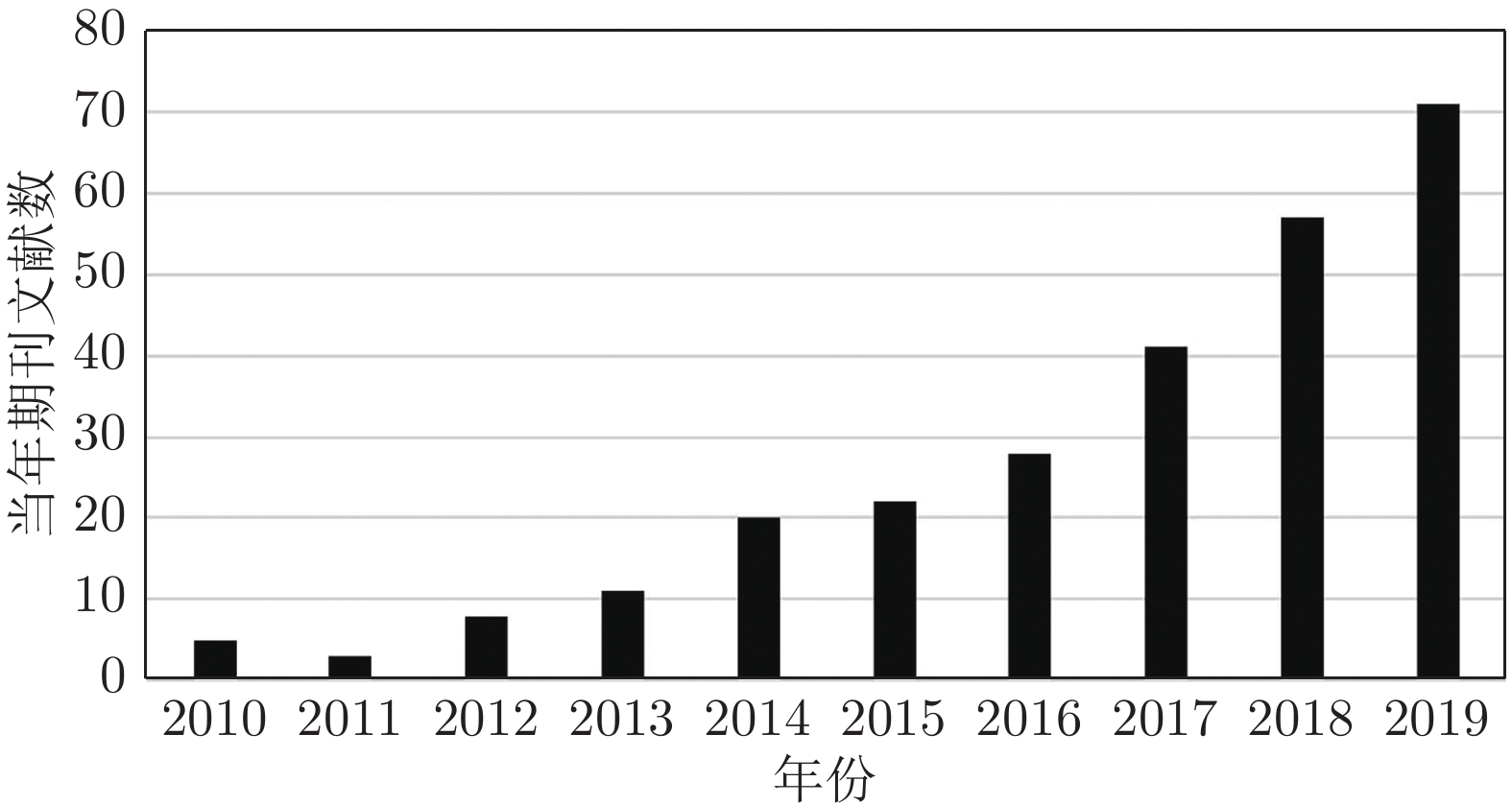
 下载:
下载:
